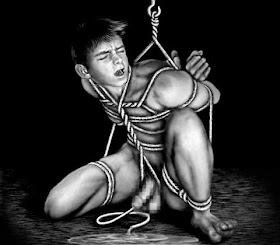 |
| 1 |
The name 'Zero' is commonly attributed to a large collection of black and white, bondage photograph manipulations which first appeared in the early 2000's (I believe).
 |
| 2 |
These pictures have become classics, partly due to the wide variety of bondage torments they depict but also because of the quality and clarity of the images. At the time they first appeared they were startlingly groundbreaking and they still hold their own against modern colour photographs because they are focused entirely on the bondage predicament - and some inventive punishment options not easily demonstrated with a live model!
 |
| 3 |
These pictures could almost be illustrations from a handbook of bondage technique, so clearly is the ropework shown. The black and white palette and absence of background detail contributes to this 'academic' effect. The images seem timeless with no clothing or background detail to give away context. The only possible clue to their era is the models' head hair, but it's usually neither excessively long nor severely short. In short they all look 'normal', 'guy next door', 'average joe' - call it what you will. These men's looks could be found in any era, so they still seem modern to us now. The very neutrality of the captives' appearance adds a subtle sense that these unfortunates are not dungeon enthusiasts, but might just have been plucked from their everyday lives in offices and shops to demonstrate for us. In this case, performing a backbreaking suspension where the heavy ball is doing more than just stretch his appendage.
 |
| 4 |
It seems that nothing is known about the creator of these remarkable images. Since many of them have the sex organs pixilated, like this one, we may surmise that he was Japanese. You might draw a similar conclusion from the abundance of complex, Shibari-style ropework which was a relative rarity on the internet, pre-Van Darkholme. The awkward posture forced on the captive in this example illustrates the potential that Shibari has for passively inflicting punishment, the position becoming increasingly painful with the passage of time. The toe-twiddling foot and other detail seems to corroborate that the discomfort is starting to bite. You'll see interesting feet in some of the other images too, it was evidently an area of interest to the creator.
 |
| 5 |
Agonised and remarkably expressive feet are prominent in this leg-spreading image too. I suspect the original source is one of the quirky series of limb-stretching torments inflicted on
Paul Perris by Can-Am (Zeus) in 1999 (example below) although I can't find this particular one. You can see how much effort has gone into tidying up and embellishing the new image and how the rope detail has been enhanced and added to.
 |
| Paul Perris in bondage for Zeus/Can-Am |
A captive who lacks Paul Perris's degree of flexibility is totally dependent on his captor's ropes giving support to his body if he is to avoid increasingly dire consequences or forcibly acquiring a new party trick.
 |
| 6 |
Most
of the images in this series do not show the captor or other
participants. Where they are shown they are active, contributing to the
victim's discomfort, not merely gloating or groping him.
The process of tying-up the captive is an aspect of
bondage I always find particularly erotic, so you can imagine I like this one very much. The cleverly simplified image removes the visual confusion that normally surrounds this process. This more complex 3-man composition reinforces the impression of an artist with an eye for good picture. The supplementary activity of the captor to the right underlines that this is the crucial moment of surrender and prompts us to imagine what lies in store for the now-defenceless captive. Once you've seen the other pictures you know it won't just be a matter of relaxing and flexing in his ropes, like a 'Captured Guy'. In practice tying up an unwilling victim is extremely difficult, it's not that easy with a willing one for that matter - all that tedious rope threading! We'll just gloss over that.
Continued in Part 2







No comments:
Post a Comment